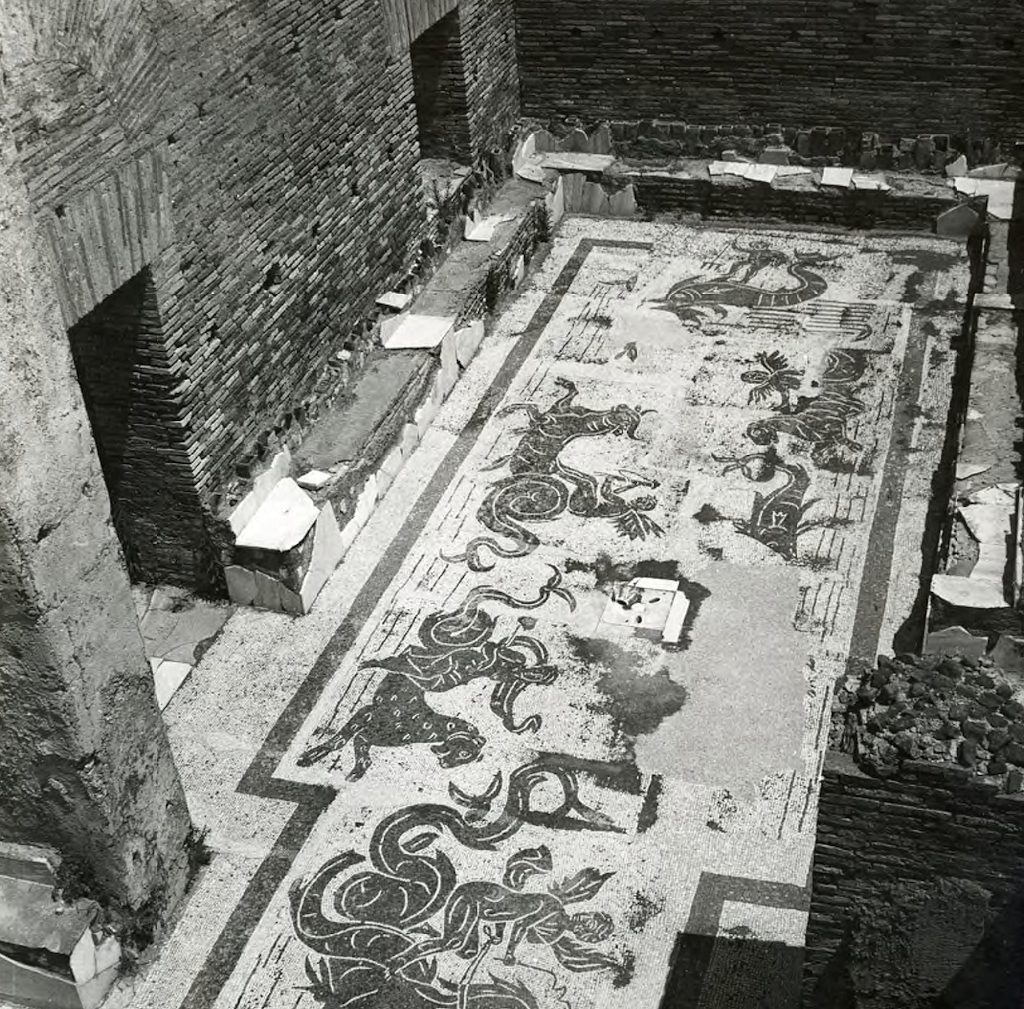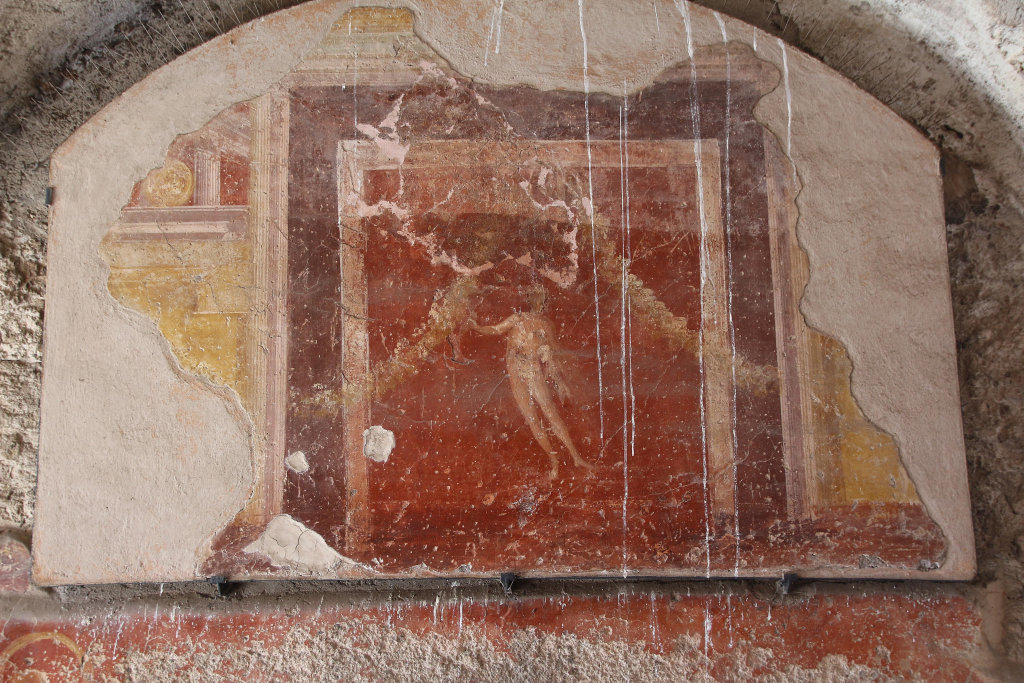The Baths of the Seven Sages form an entity with the House of the Charioteers and the House of Serapis (III,X,1 and 3). These two buildings are to the north and south of the baths, that are therefore not directly accessible from a main street. Vestibule 2, with benches, was reached from the House of Serapis.
Hadrianic and early-Antonine masonry is found in rooms 1 and 15-16, in the round hall 7, in rooms 26-33 (rows of piers), and in rooms 34-36. These rooms may originally have had a commercial function, and according to Thea Heres the large, circular hall 7 may originally have been a market. The hall was covered by a cupola. On the floor is a black-and-white mosaic with a diameter of 12 metres. Depicted are vegetative elements and hunting scenes with fifteen hunters. For the mosaic dates have been proposed around 130 AD, around 150 AD, and in the Severan period. Several statues were discovered in the hall in 1800 (described in more detail on a separate page). At some point in time the hall became a frigidarium, with a basin in room 4 to the north. In room 6 are remains of a polychrome wall-mosaic, high up on the wall and in an arch. In the tiny rooms to the east of hall 7 (10-12) are remains of paintings with vegetative motifs on a red background. Similar paintings can be seen in several rooms in the west part (16, 29, 30).
Plan of the building. Heres 1992, fig. 1.Rooms 41-44 are the oldest rooms of which it is certain that they were built as part of baths. They were erected during the reign of Antoninus Pius, c. 140 AD. Hall 42, a caldarium, had basins in three recesses, covered by barrel vaults. Between the recesses was a cross-vault. Rooms 41, 43, and 44 were service rooms used for heating air (but 43 may originally have been a caldarium).
Rooms 19-24, basins 23 and 25, and underground room 40 belong to the early third century. These rooms may have replaced earlier bathing rooms. On the floor of vestibule 19 is a black-and-white mosaic with the depiction of a naked man and the text:
IVLI CARDI H(ic) C(onspicitur) E(ffigies) Here one sees a likeness of Iulius Cardius. Iulius Cardius was probably a caretaker of the baths. It has been suggested that room 20 was an apodyterium, but on the walls are heating-pipes. In tepidarium 21 is a black-and-white mosaic with amorini, Nereids, and marine monsters. Room 22 was another tepidarium, room 24 a caldarium. To the east is service corridor 9.
To the west of corridor 27 is frigidarium 26, with a large basin. On the back wall is a painting of Venus Anadiomene (emerging from the water), between amorini, fishes, and crustaceans. It has been dated to the Severan period and was probably made by the same artists who painted Europa in the Baths of the Lighthouse (IV,II,1). Further Severan paintings can be seen in rooms 28, 29, and apodyterium 30.
In 1937 a statue of Hygieia, deity of health, was found in the building.
The room of the Seven Sages (room 5)
The building was named after the paintings in room 5. Most of the walls of this room belong to a pre-existing building from the late-Flavian period (Domitianus). The paintings belong to the Hadrianic or early-Antonine period. The "seven Greek sages" are depicted, who all lived around 600 BC. Their names and cities of origin are painted in Greek next to them:
SOLON ATHENAIOS, "Solon of Athens".
THALES MEILESIOS, "Thales of Milete".
CHEILON LAKEDAIMONIOS, "Chilon of Sparta".
[Bias] PRIENEUS, "[Bias] of Priene".
Cleobulus of Lindos, Pittacus of Mitylene, and Periander of Corinth have not been preserved.Humorous, ironic texts in Latin refer to activity in the latrine:
VT BENE CACARET VENTREM PALPAVIT SOLON, "Solon rubbed his belly to defecate well".
DVRVM CACANTES MONVIT VT NITANT THALES, "Thales recommended that those who defecate with difficulty should strain".
VISSIRE TACITE CHILON DOCVIT SVBDOLVS, "The cunning Chilon taught how to flatulate unnoticed".
[---]ENIS BIAS.Below Solon is the text IVDICI (?) | OR(di)NA (?) and VERGILIVM LEGIS(se) PVERIS. Below Thales we read VERBOSE TIBI | NEMO | DICIT DVM PRISCIANV(s) | (?) (u)TARIS XYLOSPHONGIO NOS | (? a) QVAS, "No one gives you a long lecture, Priscianus, as long as you use the sponge on a stick ...".
Below the sages the heads have been preserved of people that are probably sitting on a communal latrine (the lower part is covered by plaster that was added later and by a bench). We can read what they say:
MVLIONE SEDES, PROPERO, "I'm making haste".
AGITA TE CELERIVS | PERVENIES, "Push hard, you'll have finished more quickly".
AMICE FVGIT TE PROVERBIVM | BENE CACA ET IRRIMA MEDICOS, with an obscene meaning.Above the sages and on the vault are paintings of a flying male figure (perhaps Pan) and of amphorae, one with the word FALERNVM, referring to high-quality Campanian wine, one with the letter M. This suggests that originally the room was a bar, that was obviously visited by well-educated people. In the Antonine period new paintings covered the sages. The room may now have become part of the baths.

Vestibule 2, seen from the north.
Photo: Daniel González Acuña.

View of the interior.
Photo: Klaus Heese.

The round hall 7.
Photo: Parco Archeologico di Ostia Antica.

The round hall 7.
Photo: Wikimedia, MatthiasKabel.

The mosaic in the round hall 7.
Photo: Klaus Heese.

Room 19, mosaic of Iulius Cardius, caretaker of the baths: IVLI CARDI H(ic) C(onspicitur) E(ffigies).
Photo: Klaus Heese.

The mosaic in room 21.
Photo: American Academy Rome.

Frigidarium 26 with the painting of Venus Anadiomene.
Photo: Klaus Heese.

Detail of the painting of Venus Anadiomene.
Photo: Parco Archeologico di Ostia Antica.

Room 28, painting of a male figure and garlands.
Photo: Klaus Heese.

Room 28, painting of a man (an athlete?) and a vessel on a low table.
Photo: Wikimedia, MatthiasKabel.

Room 28, painting of a naked man (an athlete?).
Photo: Wikimedia, MatthiasKabel.

Room 30, painting of a bucket, a strigilis, a shovel, two small balls, a large ball with a "net-pattern", and a curved object with rings.
Photo: Jan Theo Bakker.

Room 6, walls and an arch decorated with a polychrome mosaic.
Photo: Jan Theo Bakker.

Room 3, painting of two persons in a boat (top),
and of a man leading two yoked oxen (bottom).
Photo: Mols 1999, fig. 60.

Statue of Hygieia, discovered in 1937.
Museo Ostiense, inv. nr. 115. Photo: R. Calza 1937, fig. 1.

Room 5, painting of the Seven Sages, general view.
Photo: Klaus Heese (click here for a photo after restoration).

Room 5, painting of the Seven Sages, general view.
Photo: Klaus Heese.

Room 5, painting of the Seven Sages, detail of Solon of Athens.
Photo: Klaus Heese (click here for a photo after restoration).

Room 5, painting of the Seven Sages, detail of Thales of Milete.
Photo: Klaus Heese (click here for a photo after restoration).

Room 5, painting of the Seven Sages.
On the upper part: an amphora and the word FALERNUM.
On the central part: Chilon of Sparta.
On the lower part: a row of men on a communal latrine.
Photo: Klaus Heese (click here for a photo after restoration).

Room 5, painting of the Seven Sages, detail of Chilon of Sparta.
Photo: Klaus Heese.